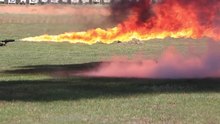Flamethrower
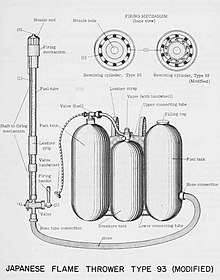

A flamethrower is a ranged incendiary device designed to project a controllable jet of fire. First deployed by the Byzantine Empire in the 7th century AD, flamethrowers saw use in modern times during World War I, and more widely in World War II as a tactical siege weapon against fortifications.
Most military flamethrowers use liquid fuel, typically either gasoline or diesel, but commercial flamethrowers are generally blowtorches using gaseous fuels such as propane; gases are safer in peacetime applications, because their flames have less mass flow rate and dissipate faster, and often are easier to extinguish when necessary.
The military use of flamethrowers is restricted through the Protocol on Incendiary Weapons.
Apart from the military applications, flamethrowers have peacetime applications where there is a need for controlled burning, such as in sugarcane harvesting and other land-management tasks. Various forms are designed for an operator to carry, while others are mounted on vehicles.
Military flamethrowers[]

Modern flamethrowers were first used during the trench warfare conditions of World War I and their use greatly increased in World War II. They can be vehicle-mounted, as on a tank, or man-portable.
The man-portable flamethrower consists of two elements—the backpack and the gun. The backpack element usually consists of two or three cylinders. In a two-cylinder system, one cylinder holds compressed, inert propellant gas (usually nitrogen), and the other holds flammable liquid, typically some form of petrochemical. A three-cylinder system often has two outer cylinders of flammable liquid and a central cylinder of propellant gas to maintain the balance of the soldier carrying it. The gas propels the liquid fuel out of the cylinder through a flexible pipe and then into the gun element of the flamethrower system. The gun consists of a small reservoir, a spring-loaded valve, and an ignition system; depressing a trigger opens the valve, allowing pressurized flammable liquid to flow and pass over the igniter and out of the gun nozzle. The igniter can be one of several ignition systems: A simple type is an electrically-heated wire coil; another used a small pilot flame, fueled with pressurized gas from the system.
Flamethrowers were primarily used against battlefield fortifications, bunkers, and other protected emplacements. A flamethrower projects a stream of flammable liquid, rather than flame, which allows bouncing the stream off walls and ceilings to project the fire into unseen spaces, such as inside bunkers or pillboxes. Typically, popular visual media depict the flamethrower as short-ranged and only effective for a few meters (due to the common use of propane gas as the fuel in flamethrowers in movies, for the safety of the actors). Contemporary flamethrowers can incinerate a target some 50–100 meters (160–330 ft) from the gunner; moreover, an unignited stream of flammable liquid can be fired and afterwards ignited, possibly by a lamp or other flame inside the bunker.
Flamethrowers pose many risks to the operator. The first disadvantage was the weapon's weight and length, which impairs the soldier's mobility. The weapon is limited to only a few seconds of burn time, since it uses fuel very quickly, requiring the operator to be precise and conservative. Flamethrowers using a fougasse-style explosive propellant system also have a limited number of shots. The weapon was very visible on the battlefield, which caused operators to become immediately singled out as prominent targets, especially for snipers and designated marksmen. Flamethrower operators were rarely taken prisoner, especially when their target survived an attack by the weapon; captured flamethrower users were in some cases summarily executed.[1]
The flamethrower's effective range is short in comparison with that of other battlefield weapons of similar size. To be effective, flamethrower soldiers must approach their target, risking exposure to enemy fire. Vehicular flamethrowers also have this problem; they may have considerably greater range than a man-portable flamethrower, but their range is still short compared with that of other infantry weapons.

The risk of a flamethrower operator being caught in the explosion of their weapon due to enemy hits on the tanks is exaggerated in films.[2] However, there are cases where the pressure tanks have exploded and killed the operator when hit by bullets or grenade shrapnel. In the documentary Vietnam in HD, platoon sergeant Charles Brown tells of how one of his men was killed when his flamethrower was hit by grenade shrapnel during the battle for Hill 875.
Flame thrower operators did not usually face a fiery death from the slightest spark or even from having their tank hit by a normal bullet as often depicted in modern war films. The Gas Container [i.e. the pressurizer] is filled with a non-flammable gas that is under high pressure. If this tank were ruptured, it might knock the operator forward as it was expended in the same way a pressurized aerosol can bursts outward when punctured. The fuel mixture in the Fuel Containers is difficult to light, which is why magnesium filled igniters are required when the weapon is fired. Fire a bullet into a metal can filled with diesel or napalm and it will merely leak out the hole unless the round was an incendiary type that could possibly ignite the mixture inside. This also applies to the flame thrower Fuel Container.[3]
The best way to minimize the disadvantages of flame weapons was to mount them on armoured vehicles. The Commonwealth and the United States were the most prolific users of vehicle-mounted flame weapons; the British and Canadians fielded "Wasps" (Universal Carriers fitted with flamethrowers) at infantry battalion level, beginning in mid-1944, and eventually incorporating them into infantry battalions. Early tank-mounted flamethrower vehicles included the "Badger" (a converted Ram tank) and the "Oke", used first at Dieppe.[2] Tank-mounted flamethrowers have the additional advantage of being more intimidating than man-portable flamethrowers as evidenced by some field reports during the Battle of Normandy where some Germans, faced with an oncoming Churchill Crocodile, had surrendered themselves to the British rather than fight them and risk being burned to death.
Operation[]
A propane-operated flamethrower is a relatively straightforward device. The gas is expelled through the gun assembly by its own pressure and is ignited at the exit of the barrel through piezo ignition.
Liquid-operated flamethrowers use a smaller tank with a pressurized gas to expel the flammable liquid fuel. The propellant gas is fed to two tubes. The first opens in the fuel tanks, providing the pressure necessary for expelling the liquid.[4] The other tube leads to an ignition chamber behind the exit of the gun assembly, where it is mixed with air and ignited through piezo ignition. This pre-ignition line is the source of the flame seen in front of the gun assembly in movies and documentaries. As the fuel passes through the flame, it is ignited and propelled towards the target.
History[]
Origins[]


The concept of throwing fire as a weapon has existed since ancient times. During the Peloponnesian War, Boeotians used some kind of a flamethrower trying to destroy the fortification walls of the Athenians during the Battle of Delium.[5] Later, during the Byzantine era, sailors used rudimentary hand-pumped flamethrowers on board their naval ships. Greek fire, extensively used by the Byzantine Empire, is said to have been invented by Kallinikos of Heliopolis, probably about 673. The flamethrower found its origins in a device consisting of a hand-held pump that shot bursts of Greek fire via a siphon-hose and a piston which ignited it with a match, similar to modern versions, as it was ejected.[6] Greek fire, used primarily at sea, gave the Byzantines a substantial military advantage against enemies such as members of the Arab Empire (who later adopted the use of Greek fire). An 11th-century illustration of its use survives in the John Skylitzes manuscript.

The Pen Huo Qi (fire spraying machine; lit. spray fire device) was a Chinese piston flamethrower that used a substance similar to petrol or naphtha, invented around 919 AD during the Five Dynasties and Ten Kingdoms period. Advances in military technology aided the Song dynasty in its defense against hostile neighbours to the north, including the Mongols. The earliest reference to Greek fire in China was made in 917 AD, written by Wu Renchen in his Spring and Autumn Annals of the Ten Kingdoms.[7] In 919 CE, the siphon projector-pump was used to spread the 'fierce fire oil' that could not be doused with water, as recorded by Lin Yu (林禹) in his Wu-Yue Beishi (吳越備史), hence the first credible Chinese reference to the flamethrower employing the chemical solution of Greek fire.[8] Lin Yu mentioned also that the 'fierce fire oil' derived ultimately from China's contact in the 'southern seas', with Arabia (大食國 Dashiguo).[9] In the Battle of Langshan Jiang (Wolf Mountain River) in 919, the naval fleet of the Wenmu King of Wuyue defeated the fleet of the Kingdom of Wu because he had used 'fire oil' to burn his fleet; this signified the first Chinese use of gunpowder in warfare, since a slow-burning match fuse was required to ignite the flames.[10] The Chinese applied the use of double-piston bellows to pump petrol out of a single cylinder (with an upstroke and a downstroke), lit at the end by a slow-burning gunpowder match to fire a continuous stream of flame (as referred to in the Wujing Zongyao manuscript of 1044 AD).[9] In the suppression of the Southern Tang state by 976 AD, early Song naval forces confronted them on the Yangtze River in 975 AD. Southern Tang forces attempted to use flamethrowers against the Song navy, but were accidentally consumed by their own fire when violent winds swept in their direction.[11] Documented also in later Chinese publications, illustrations and descriptions of mobile flamethrowers on four-wheel push carts appear in the Wujing Zongyao, written in 1044 AD (its illustration redrawn in 1601 as well).[12]
Abū ʿAbdallāh al-Khwārazmī in Mafātīḥ al-ʿUlūm (“Keys to the Sciences”) ca. 976 AD mentions the bāb al-midfa and the bāb al-mustaq which he said were parts of naphtha-throwers and projectors (al-naffātāt wa al-zarāqāt). Book of Ingenious Mechanical Device (Kitāb fī ma 'rifat al-ḥiyal al-handasiyya) of 1206 AD by Ibn al-Razzaz al-Jazari mentioned about ejectors of naphtha (zarāqāt al-naft).[13]:582
Although flamethrowers were never used in the American Civil War, the use of Greek fire was threatened, and flamethrowers have been in use in most modern conflicts ever since.[14]
Early 20th century[]
The English word flamethrower is a loan-translation of the German word Flammenwerfer, since the modern flamethrower was invented in Germany. The first flamethrower, in the modern sense, is usually credited to Richard Fiedler. He submitted evaluation models of his Flammenwerfer to the German Army in 1901. The most significant model submitted was a portable device, consisting of a vertical single cylinder 4 feet (1.2 m) long, horizontally divided in two, with pressurized gas in the lower section and flammable oil in the upper section. On depressing a lever the propellant gas forced the flammable oil into and through a rubber tube and over a simple igniting wick device in a steel nozzle. The weapon projected a jet of fire and enormous clouds of smoke some 20 yards (18 m). It was a single-shot weapon—for burst firing, a new igniter section was attached each time.

Hungarian Gábor Szakáts invented the flamethrower which was first used by the German army in WWI. Szakáts was the only Hungarian on the list of war criminals assembled by France after the war due to the invention of the flamethrower.[15] Even his birthplace Budapest refused to bury Szakáts because of his invention.[16] It was not until 1911 that the German Army accepted their first real flamethrowing device, creating a specialist regiment of twelve companies equipped with Flammenwerfer Apparent.[17] Despite this, use of fire in a World War I battle predated flamethrower use, with a petrol spray being ignited by an incendiary bomb in the Argonne-Meuse sector in October 1914.[18]
The flamethrower was first used in World War I on 26 February 1915 when it was briefly used against the French outside Verdun. On 30 July 1915 it was first used in a concerted action, against British trenches at Hooge, where the lines were 4.5 m (4.9 yd) apart—even there, the casualties were caused mainly by soldiers being flushed into the open and then shot rather than from the fire itself.[18] After two days of fighting the British had suffered casualties of 31 officers and 751 other ranks.[19]
The success of the attack prompted the German Army to adopt the device on all fronts. Flamethrowers were used in squads of six during battles, at the start of an attack destroying the enemy and to the preceding the infantry advance.[19]
The flamethrower was useful at short distances[19] but had other limitations: it was cumbersome and difficult to operate and could only be safely fired from a trench, which limited its use to areas where the opposing trenches were less than the maximum range of the weapon, namely 18 m (20 yd) apart—which was not a common situation; the fuel would also only last for about two minutes.[18]
The German deployed flamethrowers during the war in more than 650 attacks.[19]
The British experimented with flamethrowers in the Battle of the Somme, during which they used experimental weapons called "Livens Large Gallery Flame Projectors", named for their inventor, William Howard Livens, a Royal Engineers officer.[20] This weapon was enormous and completely non-portable. The weapon had an effective range of 90 yards, which proved effective at clearing trenches, but with no other benefit the project was abandoned.[19]
Two Morriss static flamethrowers were mounted in HMS Vindictive and several Hay portable flamethrowers were deployed by the Royal Navy during the Zeebrugge Raid on 23 April 1918. A British newspaper report of the action referred to the British flamethrowers only as flammenwerfer, using the German word.[21]
The French Army deployed the Schilt family of flamethrowers, which were also used by the Italian Army.[22] The Russian army used 11,446 indigenously produced flamethrowers, over 10,000 of which were the Tovarnitski man-portable design.[22]
In the interwar period, at least four flamethrowers were used in the Chaco War by the Bolivian Army, during the unsuccessful assault on the Paraguayan stronghold of Nanawa in 1933.[23]
World War II[]
The flamethrower was used extensively during World War II. In 1939, the Wehrmacht first deployed man-portable flamethrowers against the Polish Post Office in Danzig. Subsequently, in 1942, the U.S. Army introduced its own man-portable flamethrower. The vulnerability of infantry carrying backpack flamethrowers and the weapon's short range led to experiments with tank-mounted flamethrowers (flame tanks), which were used by many countries.
Axis use[]
Germany[]

A German soldier operating a flamethrower in 1944

A German soldier using a flamethrower in Russia
The Germans made considerable use of the weapon (Flammenwerfer 35) during their invasion of the Netherlands and France, against fixed fortifications. World War II German army flamethrowers tended to have one large fuel tank with the pressurizer tank fastened to its back or side. Some German army flamethrowers occupied only the lower part of its wearer's back, leaving the upper part of his back free for an ordinary rucksack.
Flamethrowers soon fell into disfavor. Flamethrowers were extensively used by German units in urban fights in Poland, both in 1943 in the Warsaw Ghetto Uprising and in 1944 in the Warsaw Uprising (see the Stroop Report and the article on the 1943 Warsaw Ghetto Uprising). With the contraction of the Third Reich during the latter half of World War II, a smaller, more compact flamethrower known as the Einstossflammenwerfer 46 was produced.
Germany also used flamethrower vehicles, most of them based on the chassis of the Sd.Kfz. 251 half track and the Panzer II and Panzer III tanks, generally known as Flammpanzers.
The Germans also produced the Abwehrflammenwerfer 42, a flame-mine or flame fougasse, based on a Soviet version of the weapon.[24] This was essentially a disposable, single use flamethrower that was buried alongside conventional land mines at key defensive points and triggered by either a trip-wire or a command wire. The weapon contained around 8 US gallons (30 l) of fuel, that was discharged within a second, to a second and a half, producing a flame with a 15-yard (14 m) range.[24] One defensive installation found in Italy included seven of the weapons, carefully concealed and wired to a central control point.[24]
Italy[]

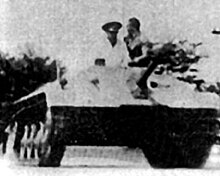
Italy employed man-portable flamethrowers and L3 Lf flame tanks during the Second Italo-Abyssinian War of 1935 to 1936, during the Spanish Civil War, and during World War II. The L3 Lf flame tank was a CV-33 or CV-35 tankette with a flamethrower operating from the machine gun mount. In the Northern Africa Theatre, the L3 Lf flame tank found little to no success.[25] An L6 Lf flametank was also developed using the L6/40 light tank platform.
Japan[]
Japan used man-portable flamethrowers to clear fortified positions, in the Battle of Wake Island,[26] Corregidor,[27] Battle of the Tenaru on the Guadalcanal[28] and Battle of Milne Bay.[29]
Romania[]
Flamethrowers were used by the Royal Romanian Army. They were also planned to become self-propelled; the Mareșal tank destroyer was planned to have a command vehicle version armed with machine guns and a flamethrower.[30]
Allies[]
Britain and the Commonwealth[]

A British World War II–type "lifebuoy" flamethrower in 1944
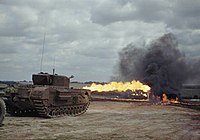
A Churchill tank fitted with a Crocodile flamethrower in action.
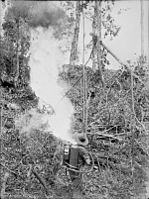
An Australian soldier fires a flamethrower at a Japanese bunker
The British World War II army flamethrowers, "Ack Packs", had a doughnut-shaped fuel tank with a small spherical pressurizer gas tank in the middle. As a result, some troops nicknamed them "lifebuoys". It was officially known as Flamethrower, Portable, No 2.
Extensive plans were made in 1940-1941 by the Petroleum Warfare Department to use Flame fougasse static flame projectors in the event of an invasion, with around 50,000 barrel-based incendiary mines being deployed in 7,000 batteries throughout Southern England.
The British hardly used their man-portable systems, relying on Churchill Crocodile tanks in the European theatre. These tanks proved very effective against German defensive positions, and caused official Axis protests against their use.[citation needed] This flamethrower could produce a jet of flame exceeding 140 metres (150 yd). There are documented instances of German units summarily executing any captured British flame-tank crews.[31]
In the Pacific theatre, Australian forces used converted Matilda tanks, known as Matilda Frogs.
United States[]

A soldier from the 33rd Infantry Division uses an M2 flamethrower

Marines engaging Japanese positions on Guam with a flamethrower.
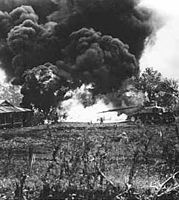
2nd Marine tank Battalion "Satan" incinerates Japanese pillbox on Saipan
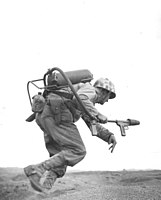
An American flamethrower operator runs under fire
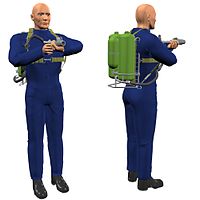
Front and rear views of a man with a M2A1-7 United States Army flamethrower
In the Pacific theatre, the U.S. Army used M-1 and M-2 flamethrowers to clear stubborn Japanese resistance from prepared defenses, caves, and trenches. Starting in New Guinea, through the closing stages on Guadalcanal and during the approach to and reconquest of the Philippines and then through the Okinawa campaign, the Army deployed hand-held, man-portable units.
Often flamethrower teams were made up of combat engineer units, later with troops of the chemical warfare service. The Army fielded more flamethrower units than the Marine Corps, and the Army's Chemical Warfare Service pioneered tank mounted flamethrowers on Sherman tanks (CWS-POA H-4). All the flamethrower tanks on Okinawa belonged to the 713th Provisional Tank Battalion. It was tasked with supporting all U.S. Army and Marine infantry. All Pacific mechanized flamethrower units were trained by Seabee specialists with Col. Unmacht's CWS Flamethrower Group in Hawaii.
The U.S. Army used flamethrowers in Europe in much smaller numbers, though they were available for special employments. Flamethrowers were deployed during the Normandy landings in order to clear Axis fortifications.[32][33] Also, most boat teams on Omaha Beach included a two-man flamethrower team.[34]
The Marine Corps used the backpack-type M2A1-7 flamethrower and M2-2 flamethrowers, also finding them useful in clearing Japanese trench and bunker complexes. The first known USMC use of the man portable flamethrower was against the formidable defenses at Tarawa in November 1943. The Marines pioneered the use of Ronson-equipped M-3 Stuart tanks in the Marianas. These were known as SATAN flame tanks. Though effective, they lacked the armor to safely engage fortifications and were phased out in favor of the better-armored M4 Sherman tanks. USMC Flamethrower Shermans were produced at Schofield Barracks by Seabees attached to the Chemical Warfare Service under Col. Unmacht. CWS designated M4s with "CWS-POA-H" for "Chemical Warfare Service Pacific Ocean Area, Hawaii" plus a flamethrower number. The Marines had previously deployed large Navy flamethrowers mounted on LVT-4 AMTRACs at Peleliu. Late in the war, both services operated LVT-4 and -5 amphibious flametanks in limited numbers. Both the Army and the Marines still used their infantry-portable systems, despite the arrival of adapted Sherman tanks with the Ronson system (cf. flame tanks).
In cases where the Japanese were entrenched in deep caves, the flames often consumed the available oxygen, suffocating the occupants. Many Japanese troops interviewed post war said they were terrified more by flamethrowers than any other American weapon. Flamethrower operators were often the first U.S. troops targeted.
Soviet Union[]

The FOG-1 and -2 flamethrowers were stationary devices used in defense. They could also be categorized as a projecting incendiary mine. The FOG had only one cylinder of fuel, which was compressed using an explosive charge and projected through a nozzle. The November 1944 issue of the US War Department Intelligence Bulletin refers to these 'Fougasse flame throwers' being used in the Soviet defense of Stalingrad. The FOG-1 was directly copied by the Germans as the Abwehrflammenwerfer 42.
Unlike the flamethrowers of the other powers during World War II, the Soviets were the only ones to consciously attempt to camouflage their infantry flamethrowers. With the ROKS-2 flamethrower this was done by disguising the flame projector as a standard issue rifle, such as the Mosin–Nagant, and the fuel tanks as a standard infantryman's rucksack. This was to try to stop the flamethrower operator from being specifically targeted by enemy fire.[35] This "rifle" had a working action which was used to cycle blank igniter cartridges.
After 1945[]
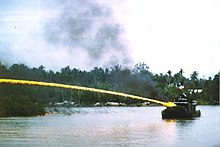

The United States Marines used flamethrowers in the Korean and Vietnam Wars. The M132 Armored Flamethrower, an M113 armored personnel carrier with a mounted flame thrower, was successfully used in the conflict.[36]
Flamethrowers have not been in the U.S. arsenal since 1978, when the Department of Defense unilaterally stopped using them — the last American infantry flamethrower was the Vietnam-era M9-7. They have been deemed of questionable effectiveness in modern combat. Despite some assertions, they are not generally banned, but as incendiary weapons they are subject to the usage prohibitions described under Protocol III of the Convention on Certain Conventional Weapons.
USA army flamethrowers developed up to the model. In the M9 the propellant tank is a sphere below the left fuel tank and does not project backwards.
Non-flamethrower incendiary weapons remain in modern military arsenals. Thermobaric weapons[37] have been fielded in Afghanistan by the United States.[38] The USA and USSR both developed a rocket launcher specifically for the deployment of incendiary munitions, respectively the M202 FLASH and the RPO "Rys" ancestor of the RPO-A Shmel.
In the last stages of the Troubles, during the mid-1980s, the IRA smuggled a number of Soviet LPO-50 military flamethrowers (supplied to them by the Libyan government) into Northern Ireland.[39] They used a flamethrower, among other weapons, to storm a British Army permanent checkpoint in Derryard, near Rosslea, on 13 December 1989.[40] Another IRA unit carried two attacks in less than a year with an improvised flamethrower towed by a tractor on a British Army watchtower, the Borucki sangar, in Crossmaglen, County Armagh, during the early 1990s. The first incident occurred on 12 December 1992,[41] when the bunker was manned by Scots Guards, and the second on 12 November 1993. The device consisted of a manure spreader which doused the facility with fuel, ignited few seconds later by a small explosion. In the 1993 action, a nine-meter-high fireball engulfed the tower for seven minutes. The four Grenadier Guards inside the outpost were rescued by a Saxon armored vehicle.[42]
Personal ownership[]
In the United States, private ownership of a flamethrower is not restricted by federal law, because flamethrower is a tool, not a firearm. Flamethrowers are legal in 48 states and restricted in California and Maryland.[43][44]
In California, unlicensed possession of a flame-throwing device—statutorily defined as "any non-stationary and transportable device designed or intended to emit or propel a burning stream of combustible or flammable liquid a distance of at least 10 feet" H&W 12750 (a)—is a misdemeanor punishable with a county jail term not exceeding one year OR with a fine not exceeding $10,000 (CA H&W 12761). Licenses to use flamethrowers are issued by the State Fire Marshal, and they may use any criteria for issuing or not issuing that license which is deemed fit, but must publish those criteria in the California Code of Regulations, Title 11, Section 970 et seq.[45][46][47][48]
In the United Kingdom, flamethrowers are a "prohibited weapon" under section 5(1)(b) of the Firearms Act 1968[49] and article 45(1)(f) of the Firearms (Northern Ireland) Order 2004 and possession of a flamethrower would carry a sentence of up to ten years' imprisonment.[50] In 1994, a man attacked school pupils at Sullivan Upper School, just outside Belfast, with a home-made flamethrower.[51]
A South African inventor brought the Blaster car-mounted flamethrower to market in 1998 as a security device to defend against carjackers.[52] It has since been discontinued, with the inventor moving on to pocket-sized self-defence flamethrowers.[53]
Elon Musk, CEO of Tesla, Inc. and owner of SpaceX, developed a "not a flamethrower" for public sale through his business, The Boring Company, selling 20,000 units. This device uses propane gas rather a stream of liquid fuel, making it more akin to a torch, like those commonly available at home and garden centers.[54]
Other uses[]
Flamethrowers are occasionally used for igniting controlled burns for land management and agriculture. For example, in the production of sugar cane, where canebrakes are burned to get rid of the dry dead leaves which clog harvesters, and incidentally kill any lurking venomous snakes. More commonly, however, a driptorch or a flare (fusee) is used.[55]
U.S. troops allegedly used flamethrowers on the streets of Washington, D.C. (mentioned in a December 1998 article in the San Francisco Flier), as one of several clearance methods used for the surprisingly large amount of snow that fell before the presidential inauguration of John F. Kennedy.[56] A history article on the U.S. Army Corps of Engineers notes, "In the end, the task force employed hundreds of dump trucks, front-end loaders, sanders, plows, rotaries, and allegedly flamethrowers to clear the way".[56]
A squad armed with backpack flamethrowers had an important part in the 2012 Summer Paralympics closing ceremony. They had one big tank each. They could make a flame about 12 feet long.
In April 2014 it was reported by South Korea's Chosun Ilbo newspaper without confirmation that a North Korean government official, O Sang-Hon, Deputy Minister at the Ministry of Public Security, was executed by flamethrower.[57]
It has been known for police to fill a "flamethrower", not with flammable liquid, but rather with tear gas dissolved in water as a riot-control device; see Converted Flamethrower 40.
See also[]
- Churchill Crocodile
- Dragon's Breath
- Early thermal weapons
- Flame gun
- Flame fougasse
- Huo Long Jing
- List of flamethrowers
- Livens Large Gallery Flame Projector
- M202A1 FLASH
- Meng Huo You
- Petroleum Warfare Department
- Technology of Song Dynasty
Citations[]
- ^ "Why Has the US Military Discontinued Use of Flamethrowers?".
- ^ Jump up to: a b "Flamethrower". canadiansoldiers.com. Archived from the original on 2007-05-18. Retrieved 2007-05-26.
- ^ Gordon, David. Weapons of the WWII Tommy
- ^ Harris, Tom (25 October 2001). "HowStuffWorks "How Flamethrowers Work"". Science.howstuffworks.com. Retrieved 2010-03-04.
- ^ "History of the Peloponnesian War" – via Wikisource.
- ^ Needham, Volume 5, 77.
- ^ Needham, Volume 5, 80.
- ^ Needham, Volume 5, 81.
- ^ Jump up to: a b Needham, Volume 5, 82.
- ^ Needham, Volume 5, Part 7, 81–83.
- ^ Needham, Volume 5, 89.
- ^ File:Battle of kedah.jpg
- ^ Needham, Joseph (1986). Science and Civilisation in China, Volume 5: Chemistry and Chemical Technology, Part 7, Military Technology: The Gunpowder Epic. Cambridge: Cambridge University Press.
- ^ History of Incendiary Weapons, and their use in the American Civil War
- ^ St. Louis Post-Dispatch from St. Louis, Missouri · Page 1, Issue Date: Saturday, 24 July 1937
- ^ Oakland Tribune from Oakland, California · Page 3, Issue Date: Monday, 26 July 1937
- ^ The New Shell Book of Firsts – Patrick Robertson (Headline)
- ^ Jump up to: a b c First World War, Willmott, H. P., Dorling Kindersley, 2003, p. 106
- ^ Jump up to: a b c d e "First World War.com - Weapons of War: Flamethrowers". www.firstworldwar.com.
- ^ Copping, Jasper (9 May 2010). "Secret terror weapon of the Somme battle 'discovered'". Daily Telegraph. London.
- ^ Daily Telegraph, 26 April 1918, reprinted in the Daily Telegraph, 26 April 2018
- ^ Jump up to: a b McNab, Chris (2015). The Flamethrower. London: Bloomsbury Publishing. pp. 16–18. ISBN 978-1472809049.
- ^ Scheina, Robert L. (2003). Latin America's Wars Volume II: The Age of the Professional Soldier, 1900-2001. Washington, D.C.: Brassey's, p. 97. ISBN 1-57488-452-2.
- ^ Jump up to: a b c "Fougasse Flame Throwers from Intelligence Bulletin, November 1944". lonesentry.com. Retrieved 3 August 2010.
- ^ World War II, Willmott, H.P., Dorling Kindersley, 2004, Page 165, ISBN 1-4053-0477-4
- ^ Devereux, Col. James P. F. "There are Japanese in the Bushes..." in The United States Marine Corps in World War II compiled and edited by S. E. Smith, Random House, 1969, p.50.
- ^ World War II, Willmott, H.P., Dorling Kindersley, 2004, Page 121, ISBN 1-4053-0477-4
- ^ p.108 Hinton, David R. Letters from the Dead: Guadalcanal 2005 Hinton Publishing
- ^ Boettcher, Brian Eleven Bloody Days: The Battle for Milne Bay self published 2009
- ^ Scafeș, Cornel (2004). "Buletinul Muzeului Național Militar, Nr. 2/2004" [Bulletin of the National Military Museum, No. 2/2004]. National Military Museum (in Romanian). Bucharest: Total Publishing., p. 229
- ^ Jarymowycz, Roman Johann (2001). Tank Tactics: From Normandy to Lorraine. Lynne Rienner Publishers. p. 199. ISBN 1-55587-950-0.
- ^ Holderfield, Randy (2001). D-Day: The Invasion of Normandy, June 6, 1944. Da Capo Press. p. 76. ISBN 1-882810-46-5.
- ^ Drez, Ronald (1998). Voices of D-Day: The Story of the Allied Invasion, Told by Those Who Were There. Louisiana State University Press. pp. 35, 201–211. ISBN 0-8071-2081-2.
- ^ Balkoski, Joseph (2004). Omaha Beach: D-Day, June 6, 1944. Stackpole Books. p. 368. ISBN 0-8117-0079-8.
- ^ Chris Bishop (2002). The Encyclopedia of Weapons of World War II. Sterling Publishing Company. pp. 270–. ISBN 978-1-58663-762-0.
- ^ Renquist, Capt. John (Summer 2008). "U.S Army Flamethrower Vehicles (Part Three of a Three-Part Series)" (Archived 2012-10-19 at the Wayback Machine). CML Army Chemical Review. Wood.army.mil.
- ^ XM1060 40mm Thermobaric Grenade. GlobalSecurity.org, 25 November 2005. Accessed 27 May 2010.
- ^ Hambling, David (May 15, 2009). "U.S. Denies Incendiary Weapon Use in Afghanistan". Wired.com. Accessed 27 May 2010.
- ^ O'Brien, Brendan (1999). The Long War: The IRA and Sinn Féin, Syracuse University Press, p. 279. ISBN 0-8156-0597-8
- ^ Moloney, Ed (2003). A secret story of the IRA. W.W. Norton & co., p. 333. ISBN 0-393-32502-4
- ^ "Loyalists fire rocket at prison canteen". The Independent. 1992-12-14. Retrieved 2019-06-07.
- ^ Harnden, Toby (2001). Bandit Country: The IRA & South Armagh. Hodder & Stoughton. pp. 123–24. ISBN 0-340-71736-X.
- ^ "See the terrifying personal flamethrower that's apparently legal in 48 states". Washington Post. Retrieved 2017-02-08.
- ^ http://xm42.com/volusion/mapRestricted.png
- ^ CA Regs (CA H&W 12756)
- ^ "Definitions and scope".
- ^ "Administration". leginfo.ca.gov. Archived from the original on 2010-01-17. Retrieved 2010-03-04.
- ^ "Enforcement and penalties". leginfo.ca.gov. Archived from the original on 2010-01-12. Retrieved 2010-03-04.
- ^ "Firearms Act 1968". www.opsi.gov.uk.
- ^ "Firearms Act 1968". www.opsi.gov.uk.
- ^ "Pupils hurt in 'flame-thrower' attack". The Independent. October 23, 2011.
- ^ "Flamethrower now an option on S. African cars". CNN. December 11, 1998. Retrieved 2010-03-04.
- ^ Fourie, Charl (2001-02-13). AM (ABC Radio) (Interview). Interviewed by Sara Sally http://www.abc.net.au/am/stories/s245655.htm. Missing or empty
|title=(help) - ^ "Elon Musk sells all 20,000 Boring Company 'flamethrowers'". The Guardian. London. February 1, 2018. Retrieved 2020-07-11.
- ^ "FAQ". throwflame.com. Retrieved 2018-02-08.
- ^ Jump up to: a b "Inauguration Weather: The Case of Kennedy". The Washington Post, Capital Weather Gang, January 5, 2009.
- ^ "North Korean official 'executed by flame-thrower'". The Daily Telegraph. London. Retrieved 2016-04-14.
General bibliography[]
- McNab, Chris (2015). The Flamethrower. London: Bloomsbury Publishing. pp. 16–18. ISBN 978-1472809049.
- Needham, Joseph (1986). Science and Civilization in China. Volume 5, Part 7. Taipei: Caves Books, Ltd.
|volume=has extra text (help) - Wictor, Thomas (2010). Flamethrower Troops of World War I. Atglen, Pennsylvania: Schiffer Publishing Ltd (USA). ISBN 978-0764335266.
External links[]
| Wikimedia Commons has media related to Flamethrowers. |
| Look up flamethrower in Wiktionary, the free dictionary. |
- First World War.com: Weapons of War: Flamethrowers
- Weapons of the World War II gyrene: Flamethrowers
- Howstuffworks "How Flamethrowers Work"
- Jaeger Platoon: Portable flame-throwers
- A history of flamethrowers
- Image of flamethrower in use
- Images, including a tank-mounted flamethrower's nozzle
- The Pen Huo Qi
- History and images of Australian flamethrowers
- WWII German army flamethrowers
- Modern Russian Flamethrowers, page in Russian
- USA-type flamethrower in use
- M42B1 Flamethrower Sherman Tank at U.S. Veterans Memorial Museum
- Flamethrowers
- Incendiary weapons
- Infantry weapons
- Light sources
